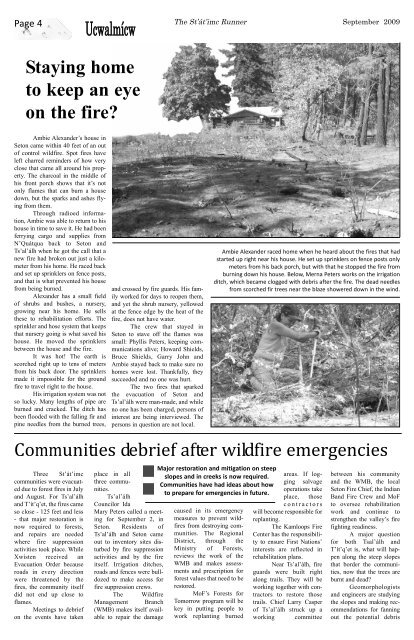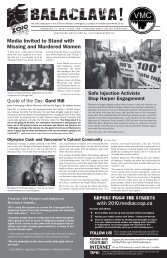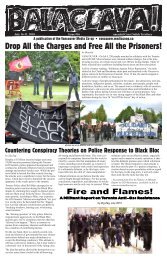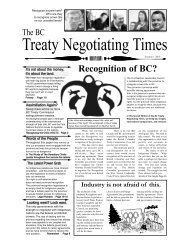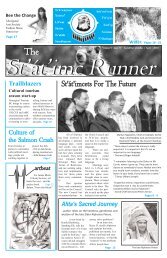St’át’imc Runner
september fp 09_Layout 1 - The Media Co-op
september fp 09_Layout 1 - The Media Co-op
You also want an ePaper? Increase the reach of your titles
YUMPU automatically turns print PDFs into web optimized ePapers that Google loves.
Page 4<br />
Ucwalmícw<br />
The <strong>St’át’imc</strong> <strong>Runner</strong> September 2009<br />
Staying home<br />
to keep an eye<br />
on the fire?<br />
Ambie Alexander’s house in<br />
Seton came within 40 feet of an out<br />
of control wildfire. Spot fires have<br />
left charred reminders of how very<br />
close that came all around his property.<br />
The charcoal in the middle of<br />
his front porch shows that it’s not<br />
only flames that can burn a house<br />
down, but the sparks and ashes flying<br />
from them.<br />
Through radioed information,<br />
Ambie was able to return to his<br />
house in time to save it. He had been<br />
ferrying cargo and supplies from<br />
N’Quátqua back to Seton and<br />
Ts’al’álh when he got the call that a<br />
new fire had broken out just a kilometer<br />
from his home. He raced back<br />
and set up sprinklers on fence posts,<br />
and that is what prevented his house<br />
from being burned.<br />
Alexander has a small field<br />
of shrubs and bushes, a nursery,<br />
growing near his home. He sells<br />
these to rehabilitation efforts. The<br />
sprinkler and hose system that keeps<br />
that nursery going is what saved his<br />
house. He moved the sprinklers<br />
between the house and the fire.<br />
It was hot! The earth is<br />
scorched right up to tens of meters<br />
from his back door. The sprinklers<br />
made it impossible for the ground<br />
fire to travel right to the house.<br />
His irrigation system was not<br />
so lucky. Many lengths of pipe are<br />
burned and cracked. The ditch has<br />
been flooded with the falling fir and<br />
pine needles from the burned trees,<br />
and crossed by fire guards. His family<br />
worked for days to reopen them,<br />
and yet the shrub nursery, yellowed<br />
at the fence edge by the heat of the<br />
fire, does not have water.<br />
The crew that stayed in<br />
Seton to stave off the flames was<br />
small: Phyllis Peters, keeping communications<br />
alive; Howard Shields,<br />
Bruce Shields, Garry John and<br />
Ambie stayed back to make sure no<br />
homes were lost. Thankfully, they<br />
succeeded and no one was hurt.<br />
The two fires that sparked<br />
the evacuation of Seton and<br />
Ts’al’álh were man-made, and while<br />
no one has been charged, persons of<br />
interest are being interviewed. The<br />
persons in question are not local.<br />
Ambie Alexander raced home when he heard about the fires that had<br />
started up right near his house. He set up sprinklers on fence posts only<br />
meters from his back porch, but with that he stopped the fire from<br />
burning down his house. Below, Merna Peters works on the irrigation<br />
ditch, which became clogged with debris after the fire. The dead needles<br />
from scorched fir trees near the blaze showered down in the wind.<br />
Communities debrief after wildfire emergencies<br />
Three <strong>St’át’imc</strong><br />
communities were evacuated<br />
due to forest fires in July<br />
and August. For Ts’al’álh<br />
and T’ít’q’et, the fires came<br />
so close - 125 feet and less<br />
- that major restoration is<br />
now required to forests,<br />
and repairs are needed<br />
where fire suppression<br />
activities took place. While<br />
Xwísten received an<br />
Evacuation Order because<br />
roads in every direction<br />
were threatened by the<br />
fires, the community itself<br />
did not end up close to<br />
flames.<br />
Meetings to debrief<br />
on the events have taken<br />
place in all<br />
three communities.<br />
. Ts’al’álh<br />
Councilor Ida<br />
Mary Peters called a meeting<br />
for September 2, in<br />
Seton. Residents of<br />
Ts’al’álh and Seton came<br />
out to inventory sites disturbed<br />
by fire suppression<br />
activities and by the fire<br />
itself. Irrigation ditches,<br />
roads and fences were bulldozed<br />
to make access for<br />
fire suppression crews.<br />
The Wildfire<br />
Management Branch<br />
(WMB) makes itself available<br />
to repair the damage<br />
Major restoration and mitigation on steep<br />
slopes and in creeks is now required.<br />
Communities have had ideas about how<br />
to prepare for emergencies in future.<br />
caused in its emergency<br />
measures to prevent wildfires<br />
from destroying communities.<br />
The Regional<br />
District, through the<br />
Ministry of Forests,<br />
reviews the work of the<br />
WMB and makes assessments<br />
and prescription for<br />
forest values that need to be<br />
restored.<br />
MoF’s Forests for<br />
Tomorrow program will be<br />
key in putting people to<br />
work replanting burned<br />
areas. If logging<br />
salvage<br />
operations take<br />
place, those<br />
contractors<br />
will become responsible for<br />
replanting.<br />
The Kamloops Fire<br />
Center has the responsibility<br />
to ensure First Nations’<br />
interests are reflected in<br />
rehabilitation plans.<br />
Near Ts’al’álh, fire<br />
guards were built right<br />
along trails. They will be<br />
working together with contractors<br />
to restore those<br />
trails. Chief Larry Casper<br />
of Ts’al’álh struck up a<br />
working committee<br />
between his community<br />
and the WMB, the local<br />
Seton Fire Chief, the Indian<br />
Band Fire Crew and MoF<br />
to oversee rehabilitation<br />
work and continue to<br />
strengthen the valley’s fire<br />
fighting readiness.<br />
A major question<br />
for both Tsal’álh and<br />
T’ít’q’et is, what will happen<br />
along the steep slopes<br />
that border the communities,<br />
now that the trees are<br />
burnt and dead?<br />
Geomorphologists<br />
and engineers are studying<br />
the slopes and making recommendations<br />
for fanning<br />
out the potential debris


